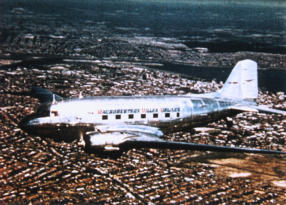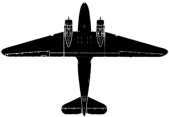
DC-3 Specifications
In MMA Service:
1945 - Jan 1970 (8 aircraft total)
Wingspan:
95ft (29m)
Length:
64ft 5.5 inches (19.6m)
Height:
16ft 11inches (5.2m)
Cruising Speed:
145knots, 167mph, 270kmph
Max takeoff weight:
26,200lb, 11,900kg
Max Fuel:
668 gallons, 3039 litres
Engines:
2 Pratt and Whitney R1830 "Wasp" twin row piston radials producing
1200HP each
Seating capacity:
2 pilots, 1 Hostess, 28 passengers
Douglas DC-3
The DC-3 was manufactured by the Douglas Aircraft Company and was
used extensively in World War Two by the Allies, then called the C-47
"Dakota". When the author commenced flying with MMA, the company
had 5 DC-3s. The DC-3 was used all over Western Australia and also
across the top end of the Northern Territory.
Pilots would fly up to 13 sectors a
day in the unpressurised DC-3
(affectionately known to the
author's children as the "Thumper"), being subjected to the hot,
rough air of the tropical north of Australia for hours on end, as well
as the bumpy frontal weather of the South West, all without a
weather radar and very few navigation aids.
I FLEW FOR MMA





DC-3 Specifications
In MMA Service:
1945 - Jan 1970
(8 aircraft total)
Wingspan:
95ft (29m)
Length:
64ft 5.5 inches (19.6m)
Height:
16ft 11inches (5.2m)
Cruising Speed:
145knots, 167mph, 270kmph
Max takeoff weight:
26,200lb, 11,900kg
Max Fuel:
668 gallons, 3039 litres
Engines:
2 Pratt and Whitney
R1830 "Wasp" twin row piston
radials producing 1200HP
each
Seating capacity:
2 pilots, 1 Hostess,
28 passengers
Douglas DC-3
The DC-3 was
manufactured by
the Douglas
Aircraft Company
and was used
extensively in
World War Two
by the Allies,
then called the C-47 "Dakota". When the
author commenced flying with MMA, the
company had 5 DC-3s. The DC-3 was used all
over Western Australia and also across the
top end of the Northern Territory.
Pilots would fly up to
13 sectors a day in the
unpressurised DC-3
(affectionately known
to the author's children
as the "Thumper"),
being subjected to the hot, rough air of the
tropical north of Australia for hours on end,
as well as the bumpy frontal weather of the
South West, all without a weather radar and
very few navigation aids.





















